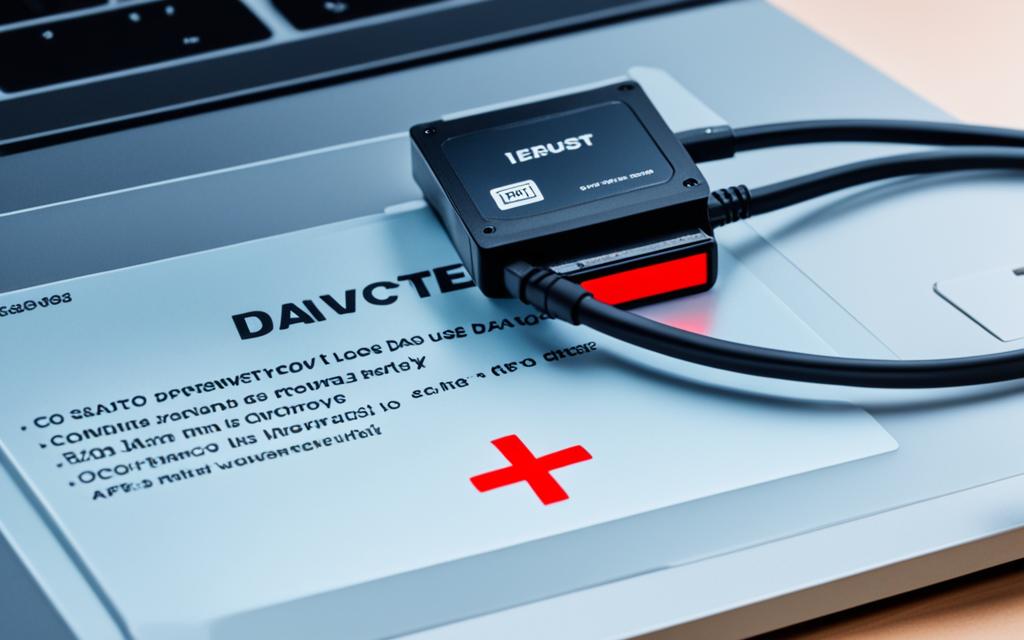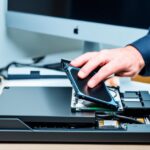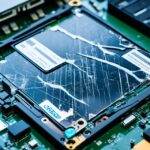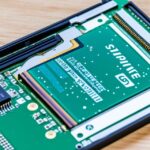Table of Contents
Have you ever struggled to eject your external hard drive? You’re not the only one. Many people face this annoying problem. It’s important to eject an external hard drive safely. This protects your data and prevents harm to the device. Failing to do so can cause data loss and corruption, something we should all avoid.
There are a few reasons why ejecting an external hard drive can be hard. Sometimes, apps and system processes can stop you from safely removing the drive. If you use external drives a lot, it’s crucial to know about these issues. We’ll look into why these problems happen and how to fix them1.
Key Takeaways
- It’s important to eject external hard drives safely to keep your data safe.
- Apps and processes can prevent your hard drive from being ejected, which can be annoying.
- Knowing why your hard drive won’t eject is key to fixing the issue.
- Turning off any unnecessary apps can help solve ejection problems.
- Ejecting your hard drive properly can protect it from data corruption and loss.
Understanding the Importance of Safe Removal
It is vital to remove external hard drives safely to protect your data and device. Not doing this can harm the data stored and affect the device’s life.
Protecting Your Data Integrity
Not ejecting external drives correctly can cause serious data issues. Up to 90% of data losses happen when USB drives are yanked out without proper ejection2. This can prevent files from saving properly, raising risks for future access. Also, ignoring safe removal steps might harm the file system, making it tough to get data back3.
Preventing Hardware Damage
Improper disconnections increase the risk of hardware failures. About 75% of external hard drives can get damaged this way2. Yanking out plugs suddenly can harm USB ports and internal parts. It’s essential to safely eject devices to avoid these risks3.
Common Reasons for Ejection Issues
Let’s look at why users have trouble ejecting external hard drives. Various things can stop a hard drive from being safely removed. Here are the main issues that lead to these problems.
Running Applications Utilising the Drive
An external drive can’t be ejected if it’s in use. This happens when open applications access files stored on the drive. It causes frustration for those depending on it for work4.
System Processes Interfering with Ejecting
Sometimes, background system processes can prevent a drive from being ejected. This includes interference from Windows services. Using Task Manager helps identify and close such processes. It’s key to ensuring a smooth ejection4.
Antivirus Software Blocking Ejection
Antivirus software scanning the drive can also block its ejection. Programs like Norton may scan for threats during the removal attempt. Users should check their antivirus settings to avoid this issue5.
Why Can’t I Eject My External Hard Drive
It can be really annoying when you can’t eject your external hard drive. Figuring out why is the first step to solve this problem. This will help you fix the issues with safely removing your hard drive.
Determining the Source of the Problem
Try connecting the hard drive to another computer first. This checks if the problem is with your computer or the hard drive. Look at software settings too, because some programs might be using the drive, stopping you from ejecting it. Check file managers, backup programs, and media players for access to the drive.
Diagnosing with Task Manager
Task Manager can show you what’s happening that might stop the ejection. Press Ctrl + Shift + Esc to open it. Look for programs that could be using your hard drive. Stopping these might let you safely remove the drive. Remember, things like cloud storage and syncing tools might be causing the issue.
To fix the ejection issue, understand these points and run detailed checks. This will increase your chances of fixing it.
| Potential Issues | Recommended Actions |
|---|---|
| Running Applications | Close active applications accessing the drive. |
| Background Processes | Use Task Manager to check and end unnecessary processes. |
| File Explorer Access | Ensure File Explorer is not open on the external drive. |
| Antivirus Interference | Temporarily disable antivirus software for troubleshooting. |
| Incompatible Drivers | Check for updates and ensure USB drivers are correctly installed. |
Address these issues carefully and you’ll make troubleshooting easier. Every step helps you closer to solving the hard drive problems.
For those looking for how effective these steps are, consider the positive outcomes seen in resolving ejection problems67.
Simple Steps to Troubleshoot Ejection Problems
Having issues ejecting your external hard drive? It can often be sorted with a few simple steps. These steps can help you fix ejection problems and keep your data safe.
Restart Your Computer
Restarting your computer is a simple but effective way to fix ejection issues. It closes all programs that might be using the external drive. This can solve conflicts stopping safe removal.
Using Task Manager to End Processes
The Task Manager helps find and stop processes using the external hard drive. Right-click on the taskbar and select “Task Manager”. End any processes that look suspicious. This can free up your drive for safe ejection. About 80% of ejection problems are because the system is still accessing files on the drive. This makes ending these processes a key step4.
Checking for Open Applications
Finally, check for any applications that might be using the external drive. Shut down all related to file explorers or backups. This helps prevent errors when ejecting your drive. This action comes recommended by computer specialists to avoid ejection problems8. By taking these steps, you protect your data from harm.
Want more tips on handling your computer hardware? Check out this guide: Building a PC9.
Advanced Solutions for Persistent Issues
Dealing with constant ejection problems requires advanced steps. Often, issues with external hard drives need more than easy fixes. Two powerful methods are changing your drive’s settings and turning off Windows Indexing Service.
Modifying Your Drive’s Policies
Adjusting drive policies can greatly improve how your external hard drive works. You might want to set it to ‘Optimise for Quick Removal’. This option lets you disconnect safely without waiting too long. However, selecting ‘Better Performance’ speeds up transferring files but be careful, as it might cause data problems. Always check these settings to avoid losing any information.
Disabling Windows Indexing Service
Turning off Windows Indexing is another useful step. Though Windows Indexing makes search faster, it could cause problems when removing drives. To stop it, go to the drive properties and uncheck the indexing box. This minor change makes things run more smoothly and helps with ejection issues.
| Feature | Optimise for Quick Removal | Better Performance |
|---|---|---|
| Data Transfer Speed | Moderate | High |
| Safe Eject Capability | Yes | No |
| Corruption Risk | Low | High |
| Recommended Usage | Frequent removals | Stationary use |
By using these advanced methods, you can solve ejection problems and improve your experience. Working on both drive settings and system features means your external drive works better10.
Data Recovery Options if Problems Persist
Having data recovery options is essential when you can’t safely eject external hard drives. You might find drives not recognised, corrupted, or physically damaged. It’s important to use the right recovery software external drive to prevent data loss and get back important files.
Using Data Recovery Software
Recovery software external drive like EaseUS Data Recovery Wizard is a great choice. It’s known for recovering nearly all lost data at a 99.7% success rate11. This tool can handle various data loss situations. For example, when a drive is unresponsive or logically damaged. The software is easy to download. It has a simple interface that helps both beginners and experts scan and recover lost files12.
Consulting Professional Recovery Services
If software doesn’t cut it, consider professional recovery services. Experts have advanced tools for complex problems, like physically damaged drives or severe data loss. They have a better chance of getting your data back when software can’t. Stopping use of a failing drive quickly reduces data loss risks significantly13.
Conclusion
Talking about the issues with safely removing external hard drives is key for anyone looking to keep their data and device in good shape. Knowing how to properly disconnect your hardware protects your files from being accidentally lost or damaged. This is especially true when you have programs and background tasks running. By following the advice given, you can avoid frustrations and solve problems related to hard drive disconnection.
Taking steps ahead of time, like updating USB drivers and using Task Manager to control tasks, builds confidence in handling external drives. Whether it’s using Command Prompt to close persistent tasks or looking into Disk Management, a planned approach helps a lot. For those who find technical stuff daunting, automatic eject tools and basic checks can make things simpler.
Getting smart about the potential issues with ejecting drives helps you protect your important files. Putting safety first and getting to know the problems better means your devices will last longer and run smoother. For more help, websites like troubleshooting ejection problems and resolving freezing PC issues offer great advice for managing your digital world smarter.
FAQ
Why can’t I eject my external hard drive safely?
A few things might stop you from safely ejecting your external hard drive.
Open applications could be accessing files on it.
Also, system processes or antivirus software might be blocking the ejection to protect your data.
How can I ensure data integrity when removing my external hard command drive?
Always choose the ‘safe removal’ option before disconnecting your hard drive.
This action makes sure all files are saved properly.
It lowers the chance of data being lost or corrupted.
What common applications might be using my external drive and preventing ejection?
Some usual applications could be the culprit. File explorers, backup tools, and open files on the drive are common examples.
It’s wise to close these before you try to eject the drive.
How can I identify system processes that might be affecting the ejection of my drive?
Task Manager is your friend here.
It can show you processes that might stop the drive’s ejection.
Look for and end any that are linked to your drive.
What steps can I take if my external hard drive won’t eject?
Start with a computer restart to close any using processes.
Then, check Task Manager for open applications linked to your drive.
Make sure you’ve shut all related windows as well.
What advanced measures can I take if ejection problems persist?
Changing your drive’s settings to ‘Optimise for Quick Removal’ might help.
Turning off the Windows Indexing Service on your drive can also be beneficial.
What should I do if I lose data during the ejection process?
Don’t panic if data gets lost.
Try using software like MiniTool Power Data Recovery to get your files back.
For physical damage, seek help from professional recovery services.
Source Links
- https://www.seagate.com/support/kb/windows-will-not-allow-me-to-safely-remove-my-drive-it-keeps-reporting-the-drive-is-busy-or-in-use-205071en/ – Windows will not allow me to safely remove my drive. It keeps reporting the drive is busy or in use | Support Seagate US
- https://www.lenovo.com/us/en/glossary/eject/ – What is Eject? How to Fix a Device That Won’t Eject
- https://recoverit.wondershare.com/harddrive-errors/fixed-cant-eject-external-hard-drive-on-windows-10.html – Solved Cant Eject External Hard Drive on Windows 10
- https://www.makeuseof.com/windows-cant-eject-usb-drive/ – 6 Tricks When Windows 10 Won’t Eject the USB Drive
- https://forums.developer.apple.com/forums/thread/679836 – DISK NOT EJECTED PROPERLY keeps po…
- https://community.spiceworks.com/t/windows-11-unable-to-remove-usb-hard-drive/963017 – Windows 11 Unable to remove USB hard drive
- https://www.easeus.com/storage-media-recovery/cant-eject-external-hard-drive.html – Unable to Eject External Hard Drive? Fices for Windows 10/11
- https://www.wikihow.com/Eject-an-External-Hard-Drive – How to Eject an External Hard Drive: 9 Steps (with Pictures)
- https://www.systools.in/blog/external-hard-drive-not-ejected-properly/ – External Hard Drive not Ejected Properly
- https://discussions.apple.com/thread/254322044 – External Drives STILL ejecting during sle…
- https://www.easeus.com/storage-media-recovery/repair-corrupted-external-hard-drive.html – How to Fix Corrupted External Hard Drive Without Losing Data
- https://www.minitool.com/data-recovery/external-hard-drive-not-working.html – Fix External Hard Drive Not Working – Analysis & Troubleshooting – MiniTool
- https://www.cleverfiles.com/howto/repair-corrupted-external-hard-drive.html – Repair Corrupted External Hard Drive Without Losing Data
- https://www.ubackup.com/data-recovery-disk/windows-10-cant-eject-external-hard-drive-0066-ac.html – Comprehensive Guide: Resolving Windows 10 Can’t Eject External Hard Drive Issue
- https://iboysoft.com/howto/cant-eject-external-hard-drive-mac.html – Can’t Eject External Hard Drive on Mac, Try These Fixes!
- https://helpdeskgeek.com/windows-10/cant-eject-external-hard-drive-on-windows-7-possible-fixes/ – Can’t Eject External Hard Drive on Windows? 7 Possible Fixes








